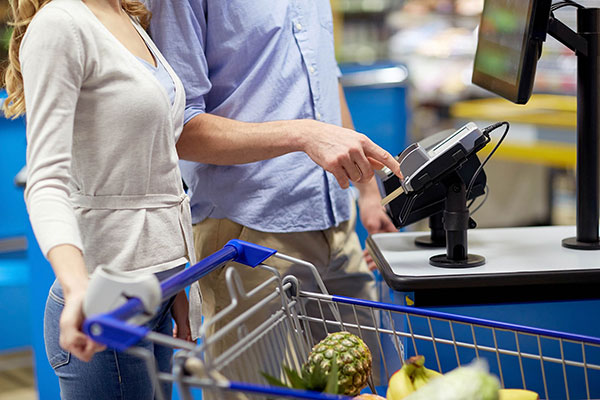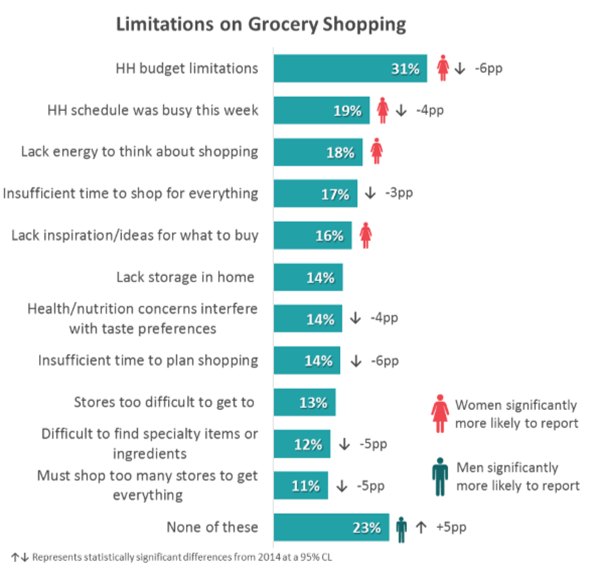Checkout Without the Lines? Consumers Weigh In on Grocery Experiments in Payment
 “I’m always looking for more convenience and ways to save time.” Yep, no surprise here. These shoppers’ sentiments pretty much sum up the prevailing wisdom (and more than a bit of our own solid research) that says today’s consumers loathe the inconvenience of waiting in line to pay for their groceries.
“I’m always looking for more convenience and ways to save time.” Yep, no surprise here. These shoppers’ sentiments pretty much sum up the prevailing wisdom (and more than a bit of our own solid research) that says today’s consumers loathe the inconvenience of waiting in line to pay for their groceries.
The single biggest narrative underlying grocery shoppers’ evolving behavior is their belief that their lives are “more chaotic and hectic than ever before.” Shoppers today are feeling increasingly time-constrained.
Historically, food retailers have been pioneers in turning to technology to help solve issues around the rapidly changing shopping environment. Getting people to move through checkout lines quickly was the impetus behind the invention of product scanning and the Universal Product Code (UPC). The first UPC bar code was scanned in a Marsh supermarket in Ohio in 1974, and food retailers haven’t looked back since.
The noble pursuit of making the checkout “faster, quicker and more convenient” led to the introduction of “express” checkout lanes, followed by the contemporary self-checkout solutions. What’s next? No checkout? Scan as you shop?
In January 2018, online super-retailer Amazon unveiled their version of this construct with the opening of Amazon Go brick-and-mortar convenience-type store. According to Amazon’s website, Amazon Go is “a new kind of store with no checkout required. We created the world’s most advanced shopping technology so you never have to wait in line. With our Just Walk Out Shopping experience, simply use the Amazon Go app to enter the store, take the products you want, and go! No lines, no checkout. (No, seriously.)”
In the grand scheme of the overall grocery shopping experience, what are the top issues that make shopping for food and beverages more difficult? As the following chart depicts, increasingly, consumers want to use their time in more compelling ways than for uninspired shopping trips and food preparation chores. And retailers should be looking for ways to create convenient, efficient and intuitive shopping experiences to serve those needs.

Source: Food Shopping in America 2017 report, The Hartman Group
Budget, lack of energy and busy schedules are still the biggest overall barriers to grocery shopping. All are felt more keenly by women, again suggesting the sense that shopping is their chore, with all the obligation to plan in advance, budget, find deals and get everyone’s favorite products while still keeping nutrition in mind. It’s little wonder, then, that after the shopping is done, all people want to do is get out of the store quickly and without fuss. Which brings us back to technology.
The Checkout Experience: Reduce, Eliminate, Rethink
We recently asked consumers about technology designed to reduce or eliminate checkout lines.
Here’s what we asked: You may have noticed that retailers are experimenting with new ways to eliminate or reduce checkout lines, like the new cashier-less Amazon store in Seattle and other scan-as-you-go technologies. How do you think it could benefit your shopping experience?
And here’s a sampling of what they told us. Not surprisingly, a lot of expectations have been formed around self-checkout and scan-as-you-go experiences.
“I think little annoyances will slow things way down. I hate having self-checkout need for help with coupons or to ID for alcohol purchases.” Female, 40 years of age
“It would save me time unless there is an issue that requires assistance, which would slow things down and frustrate me.” Male, 41 years of age
“I’m a bargain shopper who uses loyalty cards, coupons, in-store specials and rebates. What do I do if something rings up incorrectly? How can I use coupons? I like to redeem coupons and I am afraid they will eliminate this option altogether. Where’s my receipt for rebates?” Female, 38 years of age
“I think the idea is great, but I fear the learning curve on the technology might be steep. Technology is so temperamental, I wonder what would happen when it was down. Would there be any backup? Would it increase store loss and shrinkage?” Female, 42 years of age
“Scanning is fine until something goes wrong and you need a real human being to bypass the machine, and it is then that you end up waiting and not saving time.” Male, 43 years of age
“In general, it benefits my shopping experience when it actually works. Some stores have this down to a science, and you can actually check yourself out quickly and efficiently. Others...not so much. Things don't scan, prices come up wrong, coupons don't scan, payment options don't work...and you spend more time calling/waiting for an associate to come fix it than if you'd just waited in the regular line and had a cashier do all the work. I do think stores should implement a small discount to pass along some of their savings (not having to pay cashiers/baggers) for your purchase.” Female, 48 years of age
Cashier-less Checkout: A Work in Progress
As these consumer quotes point out, with every positive benefit associated with time-saving technologies, there are downsides to consider:
- The app/scanner is great – when it works
- In the end, the app/scanner may not end up being a time saver
- Shoppers may spend less
- Consumers still value personalized and authentic relationships with retailers
Regardless of the method, consumers do appreciate options when it comes to saving them time when combined with both fresher and richer shopping experiences.
Learn more about shifts in culture, shifts in shopping: Food Shopping in America 2017 report
